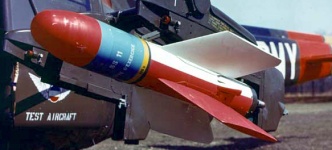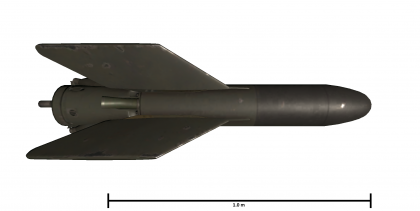Difference between revisions of "AGM-22"
(→General info: make table) |
Colok76286 (talk | contribs) (Edits) |
||
| Line 49: | Line 49: | ||
'''Pros:''' | '''Pros:''' | ||
| + | |||
* Wire-guided, allows the operator to guide the missile to the target even potentially "hidden" targets | * Wire-guided, allows the operator to guide the missile to the target even potentially "hidden" targets | ||
'''Cons:''' | '''Cons:''' | ||
| + | |||
* Limited length of wire, can disconnect and become uncontrollable | * Limited length of wire, can disconnect and become uncontrollable | ||
* Difficult to use in close, best for targets 500 m away or more | * Difficult to use in close, best for targets 500 m away or more | ||
| Line 60: | Line 62: | ||
== Media == | == Media == | ||
| − | '' | + | ''Excellent additions to the article would be video guides, screenshots from the game, and photos.'' |
== See also == | == See also == | ||
| Line 66: | Line 68: | ||
* ''reference to the article about the variant of the weapon;'' | * ''reference to the article about the variant of the weapon;'' | ||
* ''references to approximate analogues by other nations and research trees.'' --> | * ''references to approximate analogues by other nations and research trees.'' --> | ||
| + | |||
* [[SS.11]] - The original French MCLOS exported to the United States | * [[SS.11]] - The original French MCLOS exported to the United States | ||
| − | |||
| − | |||
| − | |||
== External links == | == External links == | ||
''Paste links to sources and external resources, such as:'' | ''Paste links to sources and external resources, such as:'' | ||
* ''topic on the official game forum;'' | * ''topic on the official game forum;'' | ||
| − | |||
* ''other literature.'' | * ''other literature.'' | ||
| + | |||
| + | === References === | ||
| + | <references/> | ||
{{Missiles}} | {{Missiles}} | ||
[[Category:Suspended armaments]] | [[Category:Suspended armaments]] | ||
Revision as of 22:19, 3 June 2022
Contents
Description
The AGM-22 is a manual command to line of sight (MCLOS) wire-guided anti-tank missile developed by French aviation manufacture Nord Aviation as the SS.11. In the late 1950s, the United States military cancelled its evaluation of the SSM-A-23 Dart anti-tank missile and evaluated the proven SS.11 MCLOS anti-tank missile. Upon accepting the French missile into service, the US military changed the designation from SS.11 to AGM-22 (AGM = Anti-tank Guided Missile). The missiles were immediately outfitted to UH-1B helicopters and crews from special units were trained in anti-tank combat tactics. During the Vietnam Conflict, these units were deployed and saw success against armoured targets with the usage of the AGM-22 missiles.
Being classified as an MCLOS, the AGM-22 is not a fire-and-forget type missile which will home into a target on its own, on the other hand, it requires a missile operator to “fly” the missile to its target. The missile is connected to the firing vehicle throughout its flight by a series of very thin wires. Communications conducted through the wires allowed the missile operator to guide the flying missile to its target allowing some movement around barriers and obstacles if needed. If the target was outside of the range of the total length of wires, the wires would disconnect and the missile would become an unguided rocket until it either hit its target or crashed into another object or ran out of fuel and crashed.
Vehicles equipped with this weapon
General info
| Missile characteristics | |
|---|---|
| Mass | 30 kg |
| Guidance | Semi-Automatic (SACLOS) |
| Maximum speed | 220 m/s |
| Missile guidance time | 20 secs |
| Firing range | 3.5 km |
| Explosive mass | 4.55 kg TNTeq |
| Armour penetration | 600 mm |
Effective damage
Describe the type of damage produced by this type of missile (high explosive, splash damage, etc)
Comparison with analogues
Give a comparative description of missiles that have firepower equal to this weapon.
Usage in battles
Describe situations when you would utilise this missile in-game (vehicle, pillbox, base, etc)
Pros and cons
Pros:
- Wire-guided, allows the operator to guide the missile to the target even potentially "hidden" targets
Cons:
- Limited length of wire, can disconnect and become uncontrollable
- Difficult to use in close, best for targets 500 m away or more
History
While engaged in the Vietnam Conflict, the U.S. Army in 1966 outfitted their first UH-1B helicopters to carry six of the French-designed SS-11 surface-to-surface missiles mounted on M-22 hardpoints and turned into air-to-ground missiles. The missile was far from a fire-and-forget weapon, due to the fact it required a gunner to track the missile once it was fired all the way to its target. The missile was tracked by a flare lit in the tail of the missile and the gunner would make course adjustments with a joystick to the missile while in flight. The downside to utilising this missile was that it required skilled gunners and a steady platform, difficulties hard to overcome in a battle situation where a hovering helicopter was an easy target. Due to these challenges, the AGM-22 was an unpopular weapon with the helicopter operators and in comparison to the later adopted TOW anti-tank missiles, the -22s were highly inaccurate.[1]
Media
Excellent additions to the article would be video guides, screenshots from the game, and photos.
See also
- SS.11 - The original French MCLOS exported to the United States
External links
Paste links to sources and external resources, such as:
- topic on the official game forum;
- other literature.
References
- ↑ McGowen, Stanley S., Helicopters: An Illustrated History of Their Impact (Weapons and Warfare), (2005), ABC-CLIO Publishing, ISBN: 1851094687, p. 351





